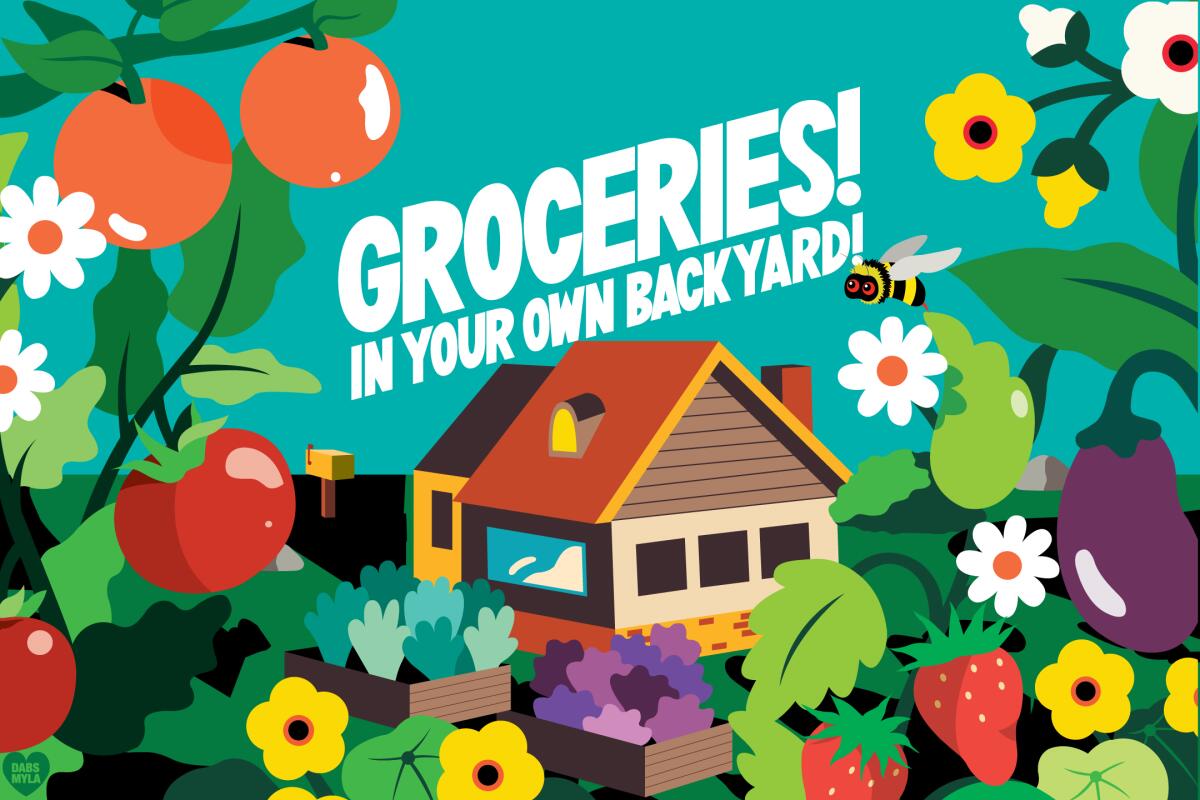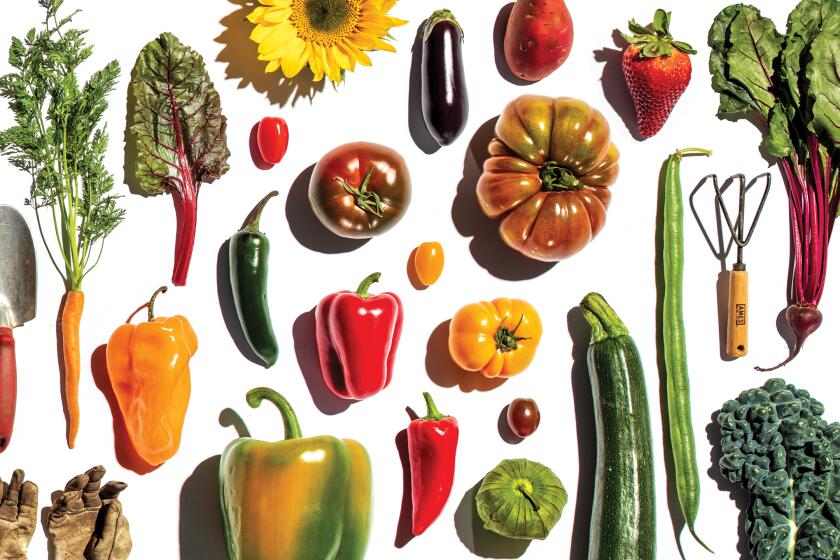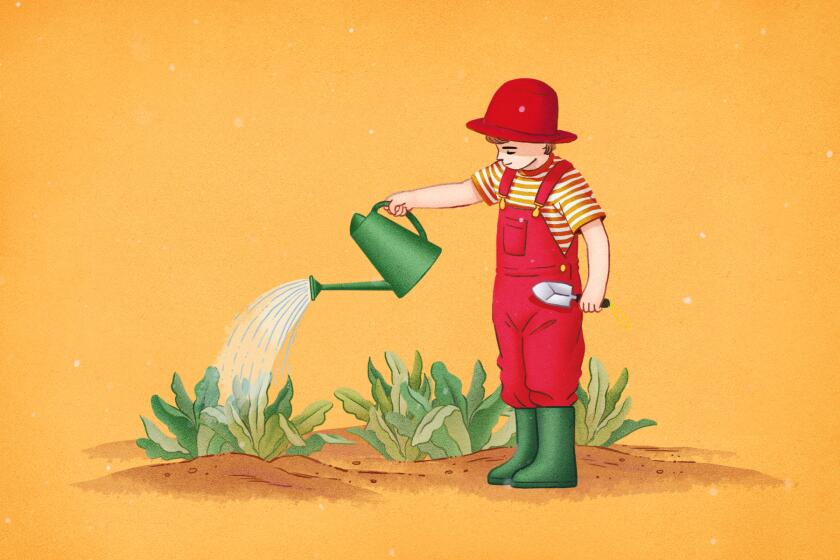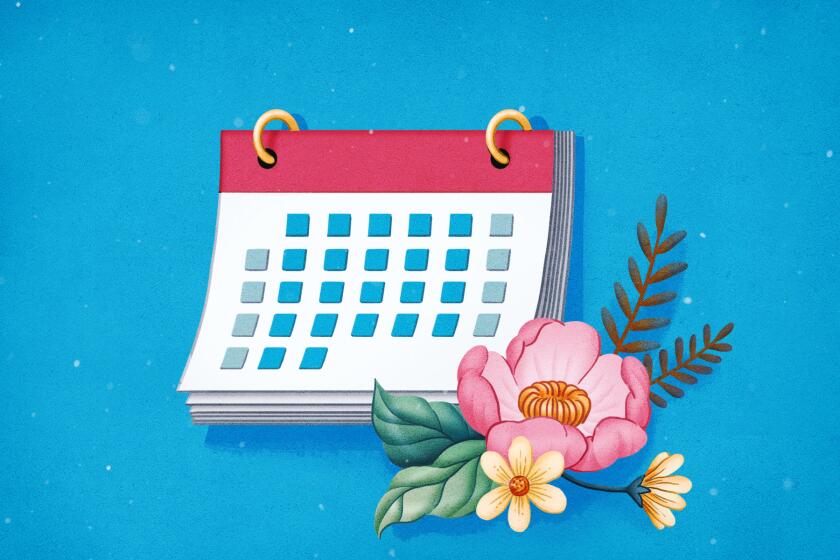DIY: Plant a victory garden now and grow your own groceries

- Share via
OK, the fallout from this pandemic is bad, but people, it’s time to stop wringing your hands.
Put down the remote, step away from the fridge and do something that can really make a difference: Create your own victory garden.
Maybe all you have room for are a few pots on a sunny balcony or windowsill. That works. Stick a tomato plant in a big, deep pot and basil by its side, and you will have the makings of a salad or marinara sauce in just a few months.
Many small nurseries have closed to visitors due to coronavirus, but you can still safely shop for plants online with a little planning and lots of patience, since most nurseries are working with reduced staff to get your orders ready for pickup.
Maybe you have room in your yard — a patch of lawn you never use anymore or a weedy corner in the sunniest part of your yard. Cover it with cardboard and 8 inches of mulch, water well and start planting, filling the holes with compost and organic potting soil until the magic of lasagna mulching creates some rich, healthy soil.
How to create your own victory garden in the coronavirus era
Yes, these are small victories against a huge, invisible enemy, but they are also a strike against helplessness, isolation and fear. It’s part of our heritage as a society: Americans tend to rebel against dictates but willingly embrace patriotic calls to action.
Seriously, what’s the downside of growing a few vegetables? Too much vitamin D from working outdoors? A farmer’s tan? So much produce you (gasp) might have to share? Food banks are already seeing double the demand. Planting food now can help you and others get through the uncertain days ahead.
Don’t stress—make a garden. Here’s what to plant in SoCal now
It’s also a great way to improve your mental health.
Take it from me; when I’m hanging by a thread, my plants keep me sane, and all they ask is a little water, sun and affection.
Here are some tips for making your own victory garden:
1. Pick a sunny spot
Find a spot for your garden plot (or pots) that gets at least six to eight hours of sunlight. Not sure? Professional gardener Lauri Kranz of Edible Gardens L.A. and co-author of “A Garden Can Be Anywhere,” recommends taking a photo of your yard every two hours between 8 a.m. and 4 p.m. to see where you can find the most consistent sun.
2. Prepare your soil
Prepping your soil before you plant is the most important thing you can do to have a successful garden (after ensuring it will get enough sun). Compost, aged steer manure, seaweed and other organic amendments can help create a rich, loamy soil full of the beneficial microbes that help your plants get the water and nutrients they need. No need to dig up all your soil; just add the layers of organic amendments and use a garden fork to mix them. If you’re short on organic amendments or time, fill your raised beds or the planting holes in your garden with organic potting soil, which is full of the healthy ingredients you need.
The coronavirus pandemic is short-circuiting the global food supply chain, disrupting the seafood, dairy and almond industries.
3. Or your containers
If you are planting in pots, use organic potting soil — never regular soil — which has all the nutrients your plants need for a good start. For deep-rooted plants like tomatoes, peppers and eggplants, choose a pot at least knee-high. Check root depth on this chart created by Los Angeles County’s Cooperative Extension office and add at least 4 inches to the estimated depths to make sure the roots have plenty of room, says master gardener Yvonne Savio, creator of the GardeninginLA.net blog.
The right plants to pick for the tiny gardener in your life.
4. How will you water?
The easiest technique is a drip irrigation system that waters automatically two to three times a week. Kranz lays half-inch irrigation hoses at one end of her raised bed boxes and then strings quarter-inch perforated hoses the length of the box, 6 inches apart. Drip irrigation is also good for keeping water off leaves to prevent mildew with plants like squash and cucumbers. Savio favors burying 5-gallon nursery buckets (the kind with drainage holes in the bottom) so the tops are 4 inches above the soil. She then plants around the buckets and fills them with water once or twice a week so the moisture goes deep into the ground. That technique encourages roots to grow deep, so they’re better protected from the summer heat. No matter what system you choose, water deeply two or three times a week, rather than short, frequent sessions that keep water from going deep in the ground.
Deep watering is the holy grail of vegetable gardening.
5. Choose your crops
Before you buy, make a plan based on your available space and the things your family will actually eat. This is a great time to be planting in Southern California, since you can still put in a crop of fast-growing salad makings — such as lettuce, arugula, spinach and radishes — that will have time to mature before the summer heat causes the plants to “bolt” or go to seed. Meanwhile, start you warm-season crops now so they can get well settled in the ground before the onset of summer’s highest heat. Corn and pumpkins may sound fun, but they require a lot of ground, so make sure you have the space. Savio and Kranz recommend choosing veggies you know your family will eat, and maybe one surprise — such as an eggplant or artichoke — to introduce your family to a new food. Tomatoes, peppers and eggplants are most easily grown from seedlings, but the pros recommend planting both seeds and seedlings with crops such as summer squash, cucumbers, beets and beans to stagger your harvests.
6. Include herbs and flowers
Include herbs in your garden, as close as possible to your kitchen door, and remember to include flowers such as cosmos, nasturtiums and sunflowers, as well as flowering herbs such as fennel and African basil. Savio has a handy list of what to plant, listed by month, on her website .
An annual is a plant that lives and dies in one growing season. A perennial regrows year after year. You should have both in your garden, and here’s why.
7. Add mulch
Once you plant, cover the soil with a thick layer (at least 4 inches) of organic mulch, such as straw, leaves or compost. Savio likes adding a thin layer of coffee grounds as well but recommends no deeper than half an inch, since the grounds can repel water if they are applied too thickly. The mulch helps preserve moisture and deter weeds while feeding the soil as it breaks down.
8. Visit regularly
Visit your garden several times a week, if not daily, to admire its progress, make sure the plants are getting enough water and head off any weed or insect infestations. Invest in a good hula hoe or diamond hoe weeder to slice weeds at their base, leaving their roots to decompose and feed the soil. When your garden plants start flowering, use an organic fertilizer to give them an extra boost to start setting fruit. Kranz prefers an organic kelp fertilizer mixed with water that she sprays on the plants, something children can do with a watering can. The pros say the best protection against pests is to keep your plants healthy and act quickly once you see an infestation. Neither Savio nor Kranz recommends chemical pesticides; instead they use blasts of water to dislodge pests like aphids or a spray made from neem oil, a natural pesticide. If the infestation is really bad, don’t get sentimental. Just pull out the infected plants, they say, and start again.
Like everything worthwhile in life, there’s always another day.
More to Read
Sign up for The Wild
We’ll help you find the best places to hike, bike and run, as well as the perfect silent spots for meditation and yoga.
You may occasionally receive promotional content from the Los Angeles Times.
















